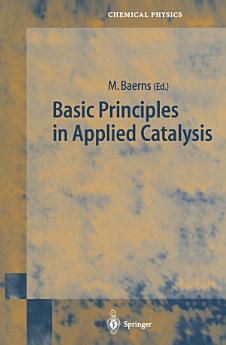Basic Principles in Applied Catalysis
Manfred Baerns
মাৰ্চ ২০১৩ · Springer Series in Chemical Physics কিতাপ 75 · Springer Science & Business Media
ইবুক
558
পৃষ্ঠা
reportমূল্যাংকন আৰু পৰ্যালোচনা সত্যাপন কৰা হোৱা নাই অধিক জানক
এই ইবুকখনৰ বিষয়ে
Applied catalysis is based nowadays not only on empirical knowledge but also on the many insights, that have been gained from the fundamental understanding of catalysis. It also comprises knowledge and expertise from catalytic reaction engineering, in particular kinetics of the catalytic reaction and its interplay with heat and mass transfer as well as fluid dynamics and the specific conditions prevailing in the type of reactor used. Applied catalysis comprises many areas from a reaction point of view, many types of catalytic materials from which catalysts are formed are needed to achieve high selectivities and space-time yields, last but not least catalysts should have a long life time to which its deactivation is detrimental. A catalytic material that fulfils all the demands then often requires special mechanical and thermal treatment to be used in practise. Various books have been written about specific areas as mentioned above. It is the intention of this contribution to present timely reports by well-recognised experts in the field to outline the state of science and technology in selected but representative areas illustrating the basic principles of applied catalysis.
এই ইবুকখনক মূল্যাংকন কৰক
আমাক আপোনাৰ মতামত জনাওক।
পঢ়াৰ নির্দেশাৱলী
স্মাৰ্টফ’ন আৰু টেবলেট
Android আৰু iPad/iPhoneৰ বাবে Google Play Books এপটো ইনষ্টল কৰক। ই স্বয়ংক্রিয়ভাৱে আপোনাৰ একাউণ্টৰ সৈতে ছিংক হয় আৰু আপুনি য'তে নাথাকক ত'তেই কোনো অডিঅ'বুক অনলাইন বা অফলাইনত শুনিবলৈ সুবিধা দিয়ে।
লেপটপ আৰু কম্পিউটাৰ
আপুনি কম্পিউটাৰৰ ৱেব ব্রাউজাৰ ব্যৱহাৰ কৰি Google Playত কিনা অডিঅ'বুকসমূহ শুনিব পাৰে।
ই-ৰীডাৰ আৰু অন্য ডিভাইচ
Kobo eReadersৰ দৰে ই-চিয়াঁহীৰ ডিভাইচসমূহত পঢ়িবলৈ, আপুনি এটা ফাইল ডাউনল’ড কৰি সেইটো আপোনাৰ ডিভাইচলৈ স্থানান্তৰণ কৰিব লাগিব। সমৰ্থিত ই-ৰিডাৰলৈ ফাইলটো কেনেকৈ স্থানান্তৰ কৰিব জানিবলৈ সহায় কেন্দ্ৰত থকা সবিশেষ নিৰ্দেশাৱলী চাওক।







